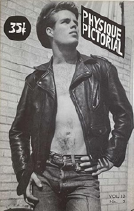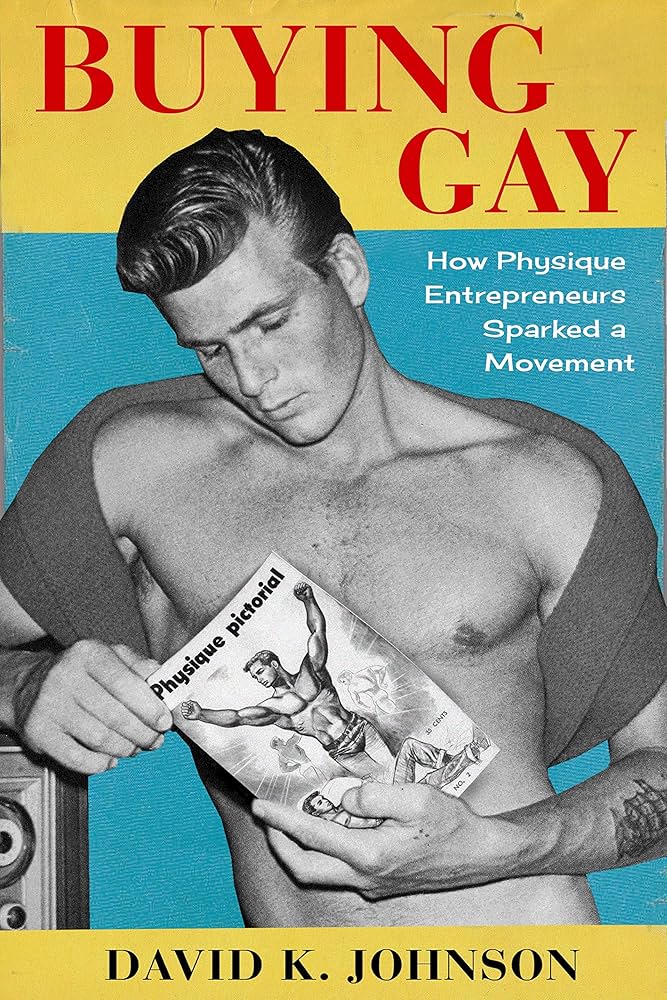Buying Gay: How Physique Entrepreneurs Sparked a Movement is a 2019 book by David K. Johnson—a professor of history at the University of South Florida. This book explores the advent of the often-overlooked physique magazines that were aimed at gay men and how these periodicals brought about gay activism in addition to consumerism before the Stonewall riots of 1969. Moreover, this work details the triumphs and setbacks faced by early gay businesses. Buying Gay earned the Best Book of 2019 award by the Over the Rainbow committee, won the Professional Prize in 2020, and claimed the John Boswell Prize in 2021. Due to its sexual content, Buying Gay is recommended for readers 18 years of age and older.
The author begins by discussing the increased visibility of men’s bodies that was attributed to the images of soldiers and sailors during World War II. It was at this time that the term beefcake was first used to describe the likes of actors Tab Hunter and Rock Hudson posing in their swim suits. Along with these developments, weightlifting and bodybuilding gained popularity. Now men needed sources of inspiration and tips on how to strengthen and train their physiques in keeping with these muscular body types. Gay men like Bob Mizer saw this interest in men’s bodies as an opportunity for other gay men to connect with one another. Thus, in 1951, Mizer launched Physique Pictorial, the first magazine created by and for gay men. Physique magazines geared toward gay men were distinct in the way they showed men with slender builds, did not include suggestions to gain weight, and depicted men eyeing one another.
The author goes on to note the shift in the representation of gay men in novels as military members and in interracial relationships. These evolving storylines lead to a new demand for books with gay characters that inspired editor Brandt Aymar to create the Corey Book Service in 1952. This book service made it easier for customers to find and stay informed about gay literature. Over the next several years, gay organizations namely the Daughters of Bilits and ONE, Inc started their own book services, which would pave the way for future LGBTQ+ bookstores.

In the chapters that follow, the author discusses various gay businesses in addition to pen pal groups that gay men could be a part of that were not limited to the physique world. For instance, consumers could subscribe to the Ah Men catalog that offered clothing specifically for gay men, notably slim pants and bathing suits. By the early ‘60s, there were so many gay businesses that a company, Directory Services, Inc., was started to assist customers with locating books, bars, and physique studios. Johnson concludes his book by looking at the lasting impact hunky guys have had on gay businesses.
Overall, Buying Gay by David K. Johnson is illuminating in the way that the text not only helps to uncover the beginning of gay businesses but also speaks to how gay men were able to form a sense of community at a time without social media. Whether these gay men lived in metropolitan areas or in small towns, physique publications and gay businesses had the ability to validate their customers’ queer identities. Although this confirmation was beneficial for many, running gay businesses came at a cost for the companies and, at times, their customers. As the author describes, all of businesses mentioned in Buying Gay were contested or faced backlash at certain points due to the fact that their customers were gay men. For the customers, they were courageous when buying gay magazines and patronizing gay establishments.
With these difficulties in mind, prospective readers can appreciate the resiliency of the innovators of the Physique Era. Johnson acknowledges the lack of racial diversity of the models featured in physique magazines as well as comments on the burgeoning groups for lesbians. By including these subjects in his analysis of the physique industries, readers are able to see the wider link between these companies and the LGBTQ+ movement. Furthermore, the scope of Johnson’s book is not just limited to gay men.
Buying Gay is well researched with all of the sources and photos being cited in the text. Johnson often ends his chapters with quotes from readers of physique magazines. These heartwarming statements provide a better understanding of the historical period and can be relatable to those who have ever questioned their identities.
LGBT Near Me, our national database of LGBTQ+ resources owe our history to those who came before us, those who where helping those in the community find each other. You can find LGBTQ+ resources at www.LGBTnearMe.org .
If you’re questioning your identity, would like to come out, or need local LGBTQ+ resources, please contact the National LGBT Help Center through the support services listed below.
Lesbian, Gay, Bisexual, and Transgender (LGBT) National Hotline: 1-888-843-4564
LGBT National Coming Out Support Hotline: 1-888-688-5428 (1-888-OUT-LGBT)
LGBT National Youth Talkline: 1-800-246-7743 (1-800-246-PRIDE)
LGBT National Senior Hotline: 1-888-234-7243
You can also reach out online at www.LGBThotline.org/chat

